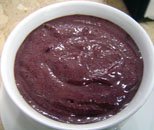Acai berry nutrition facts
Is the antioxidant content of acai berries comparable to that of well-known superfruits like pomegranate, blueberries,, and others?

|
 |
| Acai berries (Euterpe oleracea). Note dark purple, round berries. Photo courtesy: gurucrusher |
Acai pulp extract. Note dark brown, creamy-textured, dense liquid. Photo courtesy: https://www.flickr.com/photos. |
The acai berry is a tiny, sherical fruit with a rich purple hue, harvested from the acai palm tree. Botanically, acai belongs to palm or Arecaceae family of tall trees in the genus Euterpe, and botanically known as Euterpe oleracea.
Acai palm is a tall, slender tree growing to a height of 15 to 25 m. An average mature plant may possess 3-10 well-developed stems of 10-18 cm each in diameter from a single root system. It grows better under waterlogged low-lying plains receiving good annual rainfall. Each stem behaves like an individual tree and bears 3-5 bunches with each carrying hundreds of berries much similar to areca or date palm.
The acai palm is a slender, tall tree, reaching heights of 15 to 25 meters. A mature plant typically features 3-10 well-developed stems, each measuring 10-18 centimeters in diameter, originating from a single root system. It thrives in low-lying plains with abundant annual rainfall. Each stem functions as an independent tree and produces 3-5 clusters, each carrying numerous berries, resembling those of areca or date palms.
An individual acai berry is roughly the size of a small grape, measuring 2-3 centimeters in diameter. When immature, the fruits have a dark-green appearance, which deepens to a rich purple color as they ripen. Botanically, the acai fruit is categorized as a "drupe," consisting of an edible outer pulp (mesocarp) surrounding a sizable seed or stone. The mesocarp, which accounts for only about 10-15% of the berry's weight, is the edible portion.
Health benefits of Acai berry
Acai berries are packed with antioxidants, minerals, and vitamins that offer numerous health benefits and disease prevention.
Unlike other berries and fruits, acai berries are high in calories and fats, with approximately 80-250 calories per 100 grams, depending on how they are prepared and served. Traditionally, fresh acai berries have been a staple in the nutritious diet of Amazonian natives for centuries.
Acai berries contain a variety of polyphenolic anthocyanin compounds such as resveratrol, cyanidin-3-galactoside, ferulic acid, delphinidin, petunidin, as well as astringent pro-anthocyanidin tannins like epicatechin, protocatechuic acid, and ellagic acid. Scientific studies suggest that these compounds have antioxidant properties and may contribute to anti-aging, anti-inflammatory, and anti-cancer effects by combatting free radicals. Tannins in acai are also noted for their anti-infective, anti-inflammatory, and anti-hemorrhagic properties.
Research indicates that ellagic acid in acai may have anti-proliferative properties by inhibiting the DNA binding of certain carcinogenic substances (nitrosamine toxins) found in food.
Acai berries are rich in medium-chain fatty acids like oleic acid (omega-9) and linoleic acid (omega-6), which can help lower LDL cholesterol levels, raise HDL cholesterol concentrations, and reduce the risk of heart disease. These essential fats also play a role in maintaining skin moisture and preventing dryness.
Acai pulp is a good source of dietary fiber, which aids in the removal of excess cholesterol through bowel movements.
The ORAC (oxygen radical absorbance capacity) value of acai berries is believed to be in the mid-level range for fruits, surpassing oranges but falling short of pomegranates. However, the exact ORAC value for acai has not been officially validated by the USDA.
Acai berries boast a range of essential minerals, including potassium, manganese, copper, iron, and magnesium. Potassium is vital for regulating heart rate and blood pressure, while manganese acts as a co-factor for the antioxidant enzyme superoxide dismutase.
Furthermore, acai berries are rich in B-complex vitamins and vitamin-K, with adequate amounts of niacin, vitamin B-6 (pyridoxine), and riboflavin. These vitamins serve as co-factors and assist the body in metabolizing carbohydrates, proteins, and fats.
Traditional Medicinal Uses of Acai
Amazonian indigenous communities have long utilized acai berry extracts to address issues such as diarrhea, parasitic infections, hemorrhages, and ulcer management.
A decoction made from crushed acai seeds has been employed to combat fever.
In Peruvian tradition, a decoction made from acai roots has proven beneficial in treating menstrual pain, liver ailments, and malaria.
 |
Selection and storage
Fresh acai is typically only found in proximity to acai palm plantations. Acai fruits are usually harvested twice a year, with skilled workers adept at climbing trees to collect fully ripe clusters from the uppermost parts of the acai palm.
Acai is extremely perishable, and once it's harvested, it must either be consumed promptly or transported to processing facilities.
Various commercial acai products can be found in stores, including freeze-dried whole acai berries. However, it's important to note that these freeze-dried berries are nutritionally inferior to fresh ones.
Preparation and serving methods
 |
| Acai berries put for sale. Courtesy: borderlys |
The edible part of the acai fruit is the outer peel or pulp known as the mesocarp. The seeds are either discarded or used as animal fodder.
Here are some suggestions for serving acai:
Acai juice, a refreshing beverage with a distinct nutty flavor, is typically made by macerating ripe berries. To prepare it, ripe berries are soaked in lukewarm water to soften their thin outer flesh. They are then squeezed, and the large seeds are strained out, resulting in a thick, purple, creamy liquid.
Acai drinks, whether freeze-dried or in powdered juice form, are quite popular in the Americas, especially in Brazil.
Traditionally, in the tribal regions of the Amazon, acai extracts are commonly mixed with a starchy root vegetable called manioc and consumed as a delicious porridge.
Its extract can be mixed with sugar or sugarcane juice to add sweetness and be enjoyed as a beverage.
Acai extract can also be used to flavor ice creams, smoothies, shakes, liquor, and other desserts.
Furthermore, acai berries are utilized in energy-boosting nutritional supplements, available in the form of capsules, tablets, and as energy bar snacks.
Acai Palm Hearts
Acai palm hearts refer to the delicate, pale, youthful buds that sprout from the fronds of the acai palm, just above its central growth point on each stem. These hearts are a cherished byproduct of the acai tree and are used as a vegetable in a manner similar to the hearts of oil palms. Typically, they are harvested after felling a live tree stem (trunk) and removing the outer layers to reveal the central core, known as the "palm heart."
Despite their limited nutritional value, palm hearts are considered a rare delicacy, which is why they command a premium price in the market.
Safety profile
Acai berry consumption has been thoroughly assessed and found to be safe, with no reported contraindications. Pregnant women in the Amazon basin have used it without any safety concerns. To date, no instances of allergies or toxicity have been documented. (Please refer to our Medical disclaimer for more information).
Unveiling the Truth About Acai
The Acai berry hails from the Euterpe oleracea palm tree, sharing its botanical family with coconut, date palm, oil palm, and others. Acai's caloric content primarily stems from its fat content. However, it's important to note that there is no concrete scientific evidence supporting the idea that consuming acai products aids in weight loss.
Acai has been a staple in the Amazonian diet for centuries, serving as a fundamental food item rather than a trendy "superfood" like blueberries or pomegranates, which are notably low in calories.
Contrary to some claims found in various sources, acai contains antioxidants in moderate amounts. The USDA has not conducted an in-depth analysis of its nutritional profile or ORAC (Oxygen Radical Absorbance Capacity) value. It's worth noting that numerous herbs, fruits, berries, and vegetables in nature surpass acai in terms of antioxidant levels. For example, cinnamon an boasts the highest documented USDA ORAC value at 267,536 Trolox equivalents (TE), which is significantly higher than acai, as well as other items like chokeberries and apples.
Acai berries are calorie-dense and can provide a quick energy boost. However, it's essential to recognize that there are no known foods on Earth that are both high in calories and fats while simultaneously promoting weight loss.
As of now, there is no documented scientific evidence supporting the use of Acai berries as an aphrodisiac (Medical disclaimer).
≺≺- Back to Fruits from Acai berry nutrition. Visit here for impressive list of all varieties of fruits with complete illustrations of their nutrition facts and health benefits.
≺≺- Back to Home page.
Further Reading:
- NIH-National center for Complementary and Integrative Health. (opens in new window).